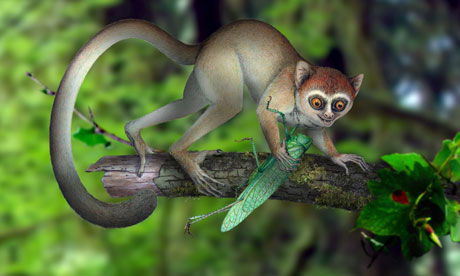The Earliest Known Primate Weighed Less Than a Golf Ball
The primate’s Latin name translates as “ancient monkey,” and the fossil is about 7 million years old

An artistic rendering of our ancient relative, snatching up insects from the trees. Photo: Xijun Ni/Chinese Academy of Sciences
About a decade ago, scientists discovered a tiny fossil in Hubei, a province just west of Shanghai. The fossil sat around for years, waiting for a detailed analysis. Now, researchers have taken the time to look closely at the ancient little animal and discovered that it showed just how long ago tree-dwellers started splitting into two groups—one which would eventually beget apes and humans and one that would beget smaller tree-dwellers, like lemurs. Nature writes:
The near-complete fossil of a tiny creature unearthed in China in 2002 has bolstered the idea that the anthropoid group of primates — whose modern-day members include monkeys, apes and humans — had appeared by at least 55 million years ago. The fossil primate does not belong to that lineage, however: it is thought to be the earliest-discovered ancestor of small tree-dwelling primates called tarsiers, showing that even at this early time, the tarsier and anthropoid groups had split apart.
The primate’s Latin name translates as “ancient monkey,” and the fossil is about 7 million years old. Because it was so small, AP reports, it probably had to eat insects more or less constantly to keep its metabolism up.
Incidentally, A. achilles would probably fare just fine if it were suddenly reintroduced into the world sometime over the coming decades. The Guardian writes that the creature lived at a time of very hot, very humid intense global warming.
More from Smithsonian.com:
A Tiny Fossilized Treasure
Computers are Good Fossil Hunters
/https://tf-cmsv2-smithsonianmag-media.s3.amazonaws.com/accounts/headshot/Rachel-Nuwer-240.jpg)
/https://tf-cmsv2-smithsonianmag-media.s3.amazonaws.com/accounts/headshot/Rachel-Nuwer-240.jpg)